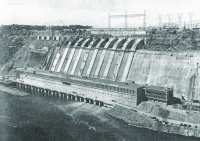Power station taps Niagara
The great size of the power station is not its only claim to interest.

Harnessing North America’s most voluminous waterfalls to produce more than 1GW of electricity from one power station wasn’t an easy task.
Nikola Tesla and George Westinghouse had built the first hydro-electric plant at Niagara Falls in 1895 and several others followed. But the post-war recovery of the 1940s and 1950s left the US and Canada hungry for more power.
Opened in 1954 by the Duchess of Kent and 25 tons of explosives, the Sir Adam Beck - Niagara No. 2 cost almost $344m and eventually had a generating capacity of 1,370MW. Although today dwarfed by China’s 22,500MW Three Gorges Dam, Adam Beck 2 was, at the time, one of the world’s largest hydro-electric plants. In 1965, a faulty transmission line from the station would leave 30 million people without electricity.
But, as The Engineer reported in October 1954, ’the great size of the power station is not by any means its only claim to the interest of the engineer, for various technical problems of unusual difficulty had to be solved in its design and construction’.
Register now to continue reading
Thanks for visiting The Engineer. You’ve now reached your monthly limit of premium content. Register for free to unlock unlimited access to all of our premium content, as well as the latest technology news, industry opinion and special reports.
Benefits of registering
-
In-depth insights and coverage of key emerging trends
-
Unrestricted access to special reports throughout the year
-
Daily technology news delivered straight to your inbox










Water Sector Talent Exodus Could Cripple The Sector
Maybe if things are essential for the running of a country and we want to pay a fair price we should be running these utilities on a not for profit...